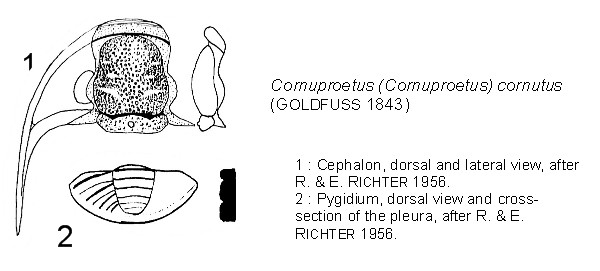
C O R N U P R O E T I N A E
Here is presented an important sub-family for the collectors that present difficulties to identify its members. This is an attempt to summary of a work of PILLET 1972 : Les trilobites du Dévonien inférieur et du Dévonien moyen du Sud-Est du Massif Armoricain. Soc. Et. Sci. Anjou. Mém N°1.
One will note that PILLET classified the cornuproetinae in the proetidae (today in the Tropidocoryphidæ).
|
Order |
Proetida |
FORTEY & OWENS 1975 |
Typically small trilobites, recently separated from Ptychopariida (different larval development). One of the Libriostomate orders (natant hypostome or derived therefrom). Exoskeleton sometimes with pits or small tubercles. Occurrence : Ordovician (Tremadoc) to Permian (Tartarian). The last of the trilobites was of this order (Phillipsiinae).
|
|
Superfamily |
Proetoidea |
SALTER 1864
|
|
|
Family |
Proetidæ |
SALTER 1864 |
|
|
Sub-family |
Cornuproetinæ |
RICHTER., RICHTER & STRUVE 1959 |
Flattened global shape.
|
| Genus | Cornuproetus | (RICHTER 1919) |
Type-species : Gerastos cornutus GOLDFUSS 1843. Sub-genera according to PILLET 1972 :
|
Observations : The genus Cornuproetus includes numerous species today split into several sub-genera. These sub-genera are extremely similar to each other and can be distinguished by details only. Nevertheless, this classification is important to help in identifying important species from a stratigraphic point of view.
Note : Diademaproetus was not considered by Pillet as a sub-genus of Cornuproetus, but of Lepidoproetus.
| Sub-genus | Cornuproetus (Cornuproetus) | (RICHTER 1919) |
Type-species : Gerastos cornutus GOLDFUSS 1843. Granulous exoskeleton.
Occurrence: Silurian – Mesodevonian. Europe, North Africa, Asia (Australia ?). Arctic Canada ? (see C. tozeri ORMISTON 1967) USA - Oklahoma ? ( see C. pictus contractus ORMISTON 1968) These 2 forms might belong to the genus Eremiproetus. |

| Sub-genus | Cornuproetus (Buchiproetus) | PILLET 1969 |
Type-species : Proetus buchi HAWLE & CORDA 1847. Granulous exoskeleton.
Occurrence: Upper Lower Devonian, lower MiddleDevonian. |
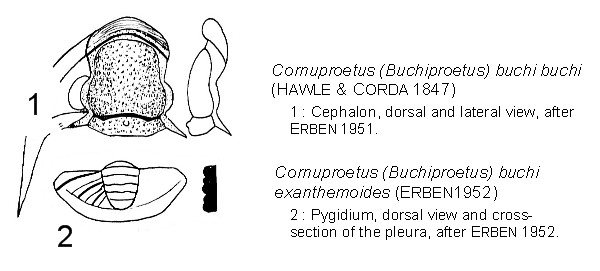
| Sub-genus | Cornuproetus (Macroblepharum) | ALBERTI 1964 |
Type-species : Cornuproetus (Macroblepharum) africanus ALBERTI 1964. Striated exoskeleton.
Occurrence: Upper Praguian. Eifelian, Morocco. |
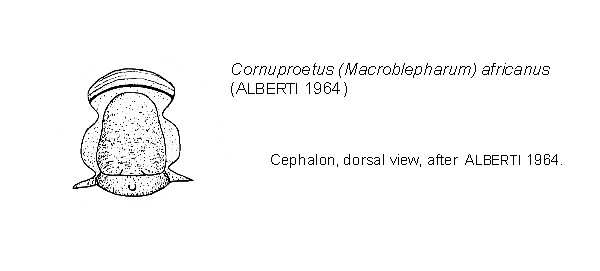
| Sub-genus | Cornuproetus (Tafilaltaspis) | ALBERTI 1966 |
Type-species : Cornuproetus (Tafilaltaspis) creber ALBERTI 1966. Granulous exoskeleton.
Occurrence: Upper Praguian. Eifelian, Morocco. |
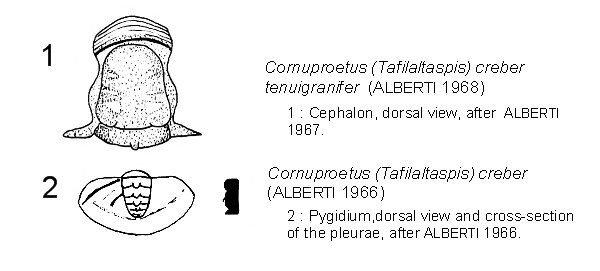
| Sub-genus | Cornuproetus (Voigtaspis) | ALBERTI 1967 | Type-species : Cornuproetus (Voigtaspis) voigti ALBERTI 1967. Granulous exoskeleton.
Occurrence: Praguian, Morocco. |
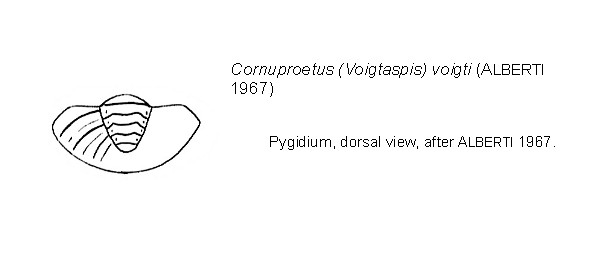
| Sub-genus | Cornuproetus (Sculptoproetus) | ERBEN 1951 |
Type-species : Proetus sculptus BARRANDE 1846. Striated exoskeleton.
Occurrence: Upper Silurian. Eiffelian. Bohemia, Germany, Morocco. |
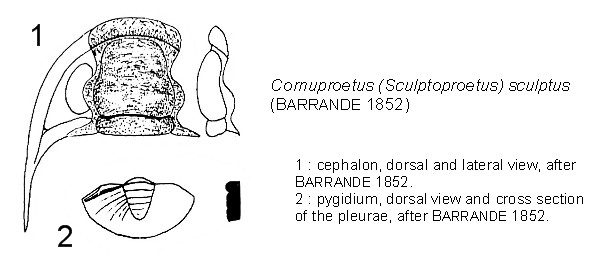
| Sub-genus | Cornuproetus (Richteraspis) | ALBERTI 1969 |
Type-species : Cornuproetus bivallatus RICHTER 1913. Granulous exoskeleton.
Occurrence: Frasnian. Germany. |
| Sub-genus | Cornuproetus ? (Francenaspis) | ALBERTI 1969 |
Type-species : Prodrevermania ? deubeli ALBERTI 1967. Unknown exoskeleton.
Occurrence: Praguian. Germany. Observation : This sub-genus might belong to Lepidoproetinae, due to its anterior border rolled up and concave. |
[*] : what I translated "alpha point" is the point where the facial suture reaches anteriorly the cephalic border. It should be written in greek, but yahoo won't accept it.
| Sub-genus | Cornuproetus ? (Proetopeltis) | PRIBYL 1965 | Type-species : Proetus neglectus BARRANDE 1852. Granulous exoskeleton.
Occurrence : Upper Lower Devonian ? – Middle Devonian. Bohemia, Germany, Morocco. Observation : the attribution to the Cornuproetus genus is doubtful because of the narrow preglabellar field and the absence of genal spines. This sub-genus doesn't belong tohte genus Proetus, but the cephalon is very similar to Quadraproetus. The pygidia are very different though. |
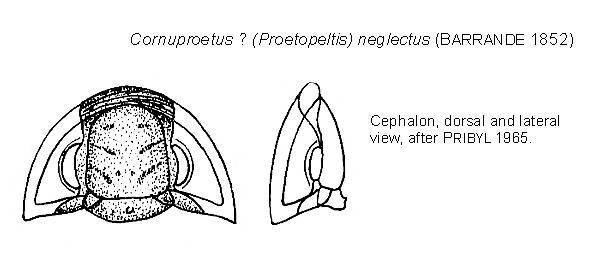
Jean PILLET. Les trilobites du Dévonien inférieur et du Dévonien moyen du Sud-Est du Massif Armoricain. Soc. Et. Sci. Anjou. Mém N°1. 1972